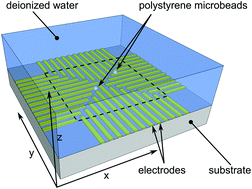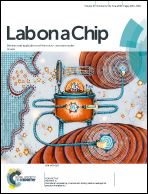Phase-shift feedback control for dielectrophoretic micromanipulation†
Abstract
In this paper, we present a novel approach to noncontact micromanipulation by controlled dielectrophoresis (DEP). To steer micro-objects in the desired way, the solutions reported in the literature use either DEP cages or amplitude modulation of the voltages applied to the electrodes. In contrast, we modulate the phases, that is, we control the phase shifts of the voltages applied to the electrodes, which simplifies the hardware implementation and extends the set of feasible forces. Furthermore, we introduce an innovative micro-electrode array layout, composed of four sectors with parallel (colinear) electrodes, which is capable of inducing an arbitrary movement in the manipulation area and is easy to fabricate using just an affordable one-layer technology. We then propose a closed-loop cascade control strategy based on real-time numerical optimization and deploy it to our experimental set-up. Numerical simulations and laboratory experiments demonstrate the manipulation capabilities such as positioning and steering of one or several microscopic objects (microspheres with a diameter of 50 μm) and even bringing two objects together and then separating them again. The results from simulations and experiments are compared and the positioning accuracy is evaluated in the whole manipulation area. The error in position is 8 μm in the worst case, which corresponds to 16% of the microsphere size or 0.7% of the manipulation range.



 Please wait while we load your content...
Please wait while we load your content...